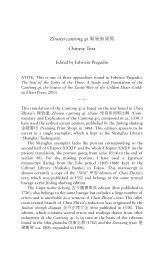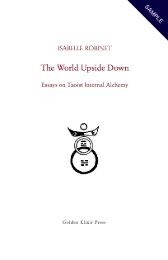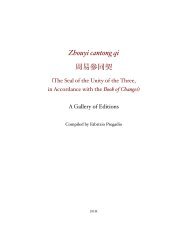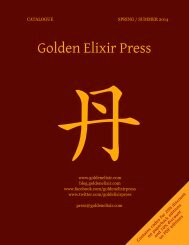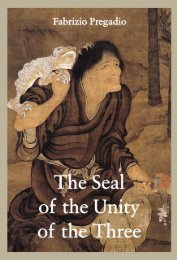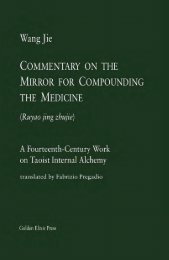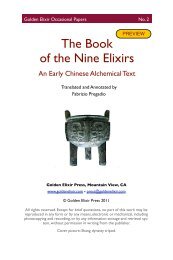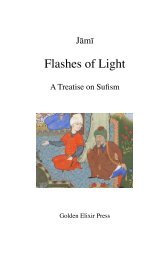The Seal of the Unity of the Three â Vol. 2 - The Golden Elixir
The Seal of the Unity of the Three â Vol. 2 - The Golden Elixir
The Seal of the Unity of the Three â Vol. 2 - The Golden Elixir
- No tags were found...
You also want an ePaper? Increase the reach of your titles
YUMPU automatically turns print PDFs into web optimized ePapers that Google loves.
190 II. Commentaries, Essays, and Related Works<br />
—————————————————————————————————————————<br />
1. PENG HAOGU<br />
[16] Guwen cantong qi 古 文 參 同 契 , 1599<br />
No precise details about Peng Haogu 彭 好 古 (fl. 1586–99, from<br />
Hubei) and his life appear to be available. His upholding <strong>the</strong> “joint<br />
cultivation <strong>of</strong> xing and ming” (xingming shuangxiu 性 命 雙 修 )<br />
suggests, however, that he was in touch with Taoist circles. In this<br />
perspective, Peng Haogu also rejects <strong>the</strong> commentaries by Chen Zhixu<br />
and Yu Yan, which he deems to be respectively related to <strong>the</strong> “Yin-<br />
Yang” and <strong>the</strong> “Qingxiu” (Pure Cultivation) branches <strong>of</strong> Neidan. 11<br />
<strong>The</strong> Guwen cantong qi (Ancient Text <strong>of</strong> <strong>the</strong> Cantong qi) is divided<br />
into <strong>the</strong> sections Jingwen 經 文 (3 pian), Jianzhu 箋 注 (3 pian), and<br />
San xianglei 三 相 類 (2 pian), and follows <strong>the</strong> sequence <strong>of</strong> <strong>the</strong> “original”<br />
Ancient Text (see <strong>the</strong> table on p. 189).<br />
2. JIANG YIBIAO<br />
[18] Guwen cantong qi jijie 古 文 參 同 契 集 解 , 1614<br />
According to his own statement, Jiang Yibiao 蔣 一 彪 (fl. 1614, from<br />
Zhejiang) based his Guwen cantong qi jijie (Collected Explications on<br />
<strong>the</strong> Ancient Text <strong>of</strong> <strong>the</strong> Cantong qi) on an edition <strong>of</strong> <strong>the</strong> Ancient Text<br />
containing Yang Shen’s preface, but no commentary. To this edition he<br />
added selections from <strong>the</strong> commentaries by Peng Xiao, Chen Xianwei,<br />
Yu Yan, and Chen Zhixu, rearranged according to <strong>the</strong> ordering <strong>of</strong> <strong>the</strong><br />
Ancient Text. <strong>The</strong> work follows <strong>the</strong> sequence <strong>of</strong> <strong>the</strong> “original” Ancient<br />
Text (see <strong>the</strong> table on p. 189), except that <strong>the</strong> portion corresponding<br />
to section 27 is found after sections 72–73. 12<br />
11<br />
<strong>The</strong>se remarks are found in <strong>the</strong> preface to <strong>the</strong> Daoyan neiwai bijue<br />
quanshu and in <strong>the</strong> preface to <strong>the</strong> Cantong qi commentary, respectively. On<br />
Peng Haogu and his works see <strong>the</strong> entry by Farzeen Baldrian-Hussein in<br />
Pregadio, ed., <strong>The</strong> Encyclopedia <strong>of</strong> Taoism, 2:785–86.<br />
12<br />
On Jiang Yibiao’s work see <strong>the</strong> descriptive note in Siku quanshu<br />
zongmu, 146.1249–50, which consists, however, almost entirely in a criticism<br />
<strong>of</strong> <strong>the</strong> Ancient Text.<br />
© Fabrizio Pregadio and <strong>Golden</strong> <strong>Elixir</strong> Press 2012



